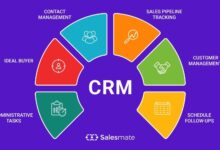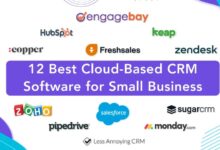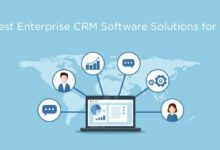CRM Software for Small Business Success
CRM Software for Small Business: Unlocking growth and efficiency is easier than you think. This guide explores how the right Customer Relationship Management (CRM) system can transform your small business operations, from streamlining sales and marketing to improving customer service and boosting overall profitability. We’ll delve into selecting the perfect CRM, implementing it effectively, and maximizing its return on investment.
From defining your specific needs to choosing between cloud-based and on-premise solutions, we’ll navigate the key considerations for small businesses of all types. We’ll cover essential features like contact management, sales pipeline tracking, and reporting, highlighting best practices for data management, integration with other business tools, and employee training. Ultimately, this guide aims to equip you with the knowledge to make informed decisions and achieve significant business improvements.
Defining Needs for Small Business CRM
A Customer Relationship Management (CRM) system can significantly boost efficiency and profitability for small businesses. Choosing the right CRM, however, requires understanding your specific needs and how a CRM can address them. This section outlines core functionalities and how those needs vary across different business types.
Core Functionalities of a Small Business CRM
Small businesses benefit from CRMs that streamline operations and improve customer interactions. Essential functionalities include contact management (centralized storage and organization of customer data), sales pipeline management (tracking leads and opportunities), and basic reporting (analyzing sales performance and customer behavior). Additional valuable features often include task management, email integration, and appointment scheduling. These tools work together to provide a holistic view of customer interactions and business performance.
CRM Needs Across Different Small Business Types
The specific CRM needs of a small business vary considerably depending on its industry and operational model.
Retail businesses, for example, primarily need robust inventory management integrated with their CRM, allowing them to track stock levels, manage orders, and analyze sales trends tied to specific products or promotions. They might also benefit from features that facilitate loyalty programs and customer segmentation for targeted marketing.
Service-based businesses, such as consulting firms or freelance professionals, prioritize features that help manage projects, track billable hours, and schedule appointments. Strong contact management and communication tools are essential for maintaining client relationships and ensuring timely service delivery.
E-commerce businesses require CRM systems tightly integrated with their online store. This integration allows for seamless tracking of customer interactions across various channels (website, email, social media), personalized marketing based on browsing history and purchase behavior, and efficient order processing and fulfillment. Advanced analytics capabilities are also highly beneficial for understanding customer journeys and optimizing conversion rates.
Comparison of CRM Features Across Pricing Tiers
The following table compares three key CRM features across different pricing tiers (represented as Low, Mid, and High). Note that specific features and pricing vary significantly between different CRM providers. This is a generalized comparison for illustrative purposes.
| Feature | Low Tier | Mid Tier | High Tier |
|---|---|---|---|
| Contact Management | Basic contact storage, limited custom fields | Advanced contact organization, custom fields, segmentation, task assignment | Advanced segmentation, automation, integration with other tools, detailed contact history |
| Sales Pipeline Management | Basic lead tracking, limited pipeline visualization | Visual pipeline management, opportunity tracking, sales forecasting | Advanced sales forecasting, automated workflows, sales analytics dashboards, predictive lead scoring |
| Reporting | Basic sales reports, limited customization | Customizable reports, sales performance dashboards | Advanced analytics, custom dashboards, real-time reporting, integration with business intelligence tools |
Exploring CRM Software Options
Choosing the right CRM software is crucial for a small business’s success. The right system can streamline operations, improve customer relationships, and ultimately boost profitability. Understanding the different options available and how they fit your specific needs is the key to making an informed decision. This section explores various CRM software options, highlighting their key features and suitability for small businesses.
Cloud-Based vs. On-Premise CRM Solutions
Cloud-based and on-premise CRM solutions offer distinct advantages and disadvantages for small businesses. Cloud-based CRMs, hosted on remote servers, offer accessibility from anywhere with an internet connection, scalability to meet growing needs, and reduced upfront costs due to the subscription model. However, they rely on a stable internet connection and may involve ongoing subscription fees. On-premise CRMs, installed and maintained on the business’s own servers, offer greater control over data security and customization but require significant upfront investment in hardware, software, and IT expertise for maintenance and updates. This often makes them a less attractive option for small businesses with limited resources. The choice depends heavily on the business’s budget, technical capabilities, and data security priorities.
Popular CRM Software Options
Several popular CRM software options cater specifically to the needs of small businesses. These systems often offer a balance of functionality and affordability.
- HubSpot CRM: A freemium option offering a robust free plan with features like contact management, deal tracking, and email integration. Paid plans unlock advanced features such as marketing automation and sales analytics. Pricing varies depending on the chosen plan and features.
- Zoho CRM: A comprehensive CRM solution with a wide range of features, including contact management, sales automation, and customer support tools. It offers a variety of pricing plans, starting with a very affordable free plan and scaling up to meet the needs of growing businesses.
- Salesforce Sales Cloud: While known for its enterprise-level solutions, Salesforce also offers plans tailored for small businesses. It’s known for its powerful automation capabilities and extensive integrations. Pricing is typically higher than other options on this list, reflecting its advanced features and robust functionality.
- Freshsales: This CRM focuses on sales automation and offers features such as lead scoring, deal management, and sales forecasting. It has a user-friendly interface and competitive pricing plans that are suitable for small businesses.
- Pipedrive: Pipedrive is a sales-focused CRM known for its simple and intuitive interface. It emphasizes ease of use and efficient sales pipeline management. Pricing is straightforward and scales with the number of users and features required.
Successful Small Business CRM Implementations
Several small businesses have successfully implemented CRM systems, leading to significant improvements in their operations. For example, a small bakery using Zoho CRM improved customer relationship management by tracking customer preferences and order history, leading to increased repeat business and personalized marketing efforts. Similarly, a boutique clothing store using HubSpot CRM streamlined its sales process, improved lead management, and enhanced communication with customers, resulting in higher sales conversion rates. These examples demonstrate how the right CRM, properly implemented, can contribute significantly to a small business’s growth and success.
Integration and Data Management
A successful small business CRM implementation hinges on seamless integration with existing tools and efficient data management. Connecting your CRM to other software platforms streamlines workflows and eliminates data silos, providing a unified view of your customer interactions. Efficient data migration ensures a smooth transition and minimizes disruption to your daily operations. Properly setting up data fields and workflows allows for customized tracking and reporting, maximizing the value of your CRM investment.
Effective data management and integration are crucial for maximizing the return on investment (ROI) of your CRM system. Without proper integration, your CRM becomes an isolated system, failing to leverage the power of your other business tools. Similarly, poor data management can lead to inaccurate reporting, missed opportunities, and ultimately, a less effective business strategy.
CRM Integration with Other Business Tools
Integrating your CRM with other business tools, such as email marketing platforms (Mailchimp, Constant Contact), accounting software (Xero, QuickBooks), and e-commerce platforms (Shopify, WooCommerce), significantly enhances efficiency and provides a holistic view of your business operations. For example, integrating your CRM with your email marketing platform allows you to segment your audience based on CRM data, leading to more targeted and effective marketing campaigns. Similarly, integration with accounting software automates invoice generation and tracks payments linked to specific customer interactions recorded within the CRM. This integrated approach reduces manual data entry, minimizes errors, and provides a more accurate picture of your financial performance tied directly to customer relationships.
Efficient Data Import and Migration
Migrating data to a new CRM system requires a methodical approach to ensure data accuracy and minimize downtime. The process typically involves exporting data from existing systems (spreadsheets, databases, legacy CRM) in a compatible format (CSV, XML). Data cleansing is crucial at this stage, correcting inconsistencies and removing duplicates. This cleaned data is then imported into the new CRM using the system’s built-in import tools or third-party integration apps. Regularly scheduled data backups are essential throughout the process, providing a safety net in case of unforeseen issues. For instance, a small business migrating from a spreadsheet-based system to a cloud-based CRM might use a CSV export from the spreadsheet, then use the CRM’s import function to populate its customer database. The process should be tested on a small subset of data before migrating the entire dataset to ensure accuracy and identify potential issues.
Setting Up Basic Data Fields and Workflows
Establishing clear and consistent data fields is fundamental to effective CRM usage. Begin by defining essential customer information fields such as name, contact details, company, and purchase history. Next, consider adding custom fields relevant to your specific business needs, like preferred communication method or sales stage. Workflows automate repetitive tasks, improving efficiency and consistency. For example, you could set up a workflow that automatically sends a welcome email to new customers or assigns leads to specific sales representatives based on criteria such as geographic location or industry. A well-defined workflow might include steps like lead qualification, opportunity creation, proposal generation, and deal closure, all tracked within the CRM. This allows for efficient management of the sales process and provides valuable insights into sales performance.
Training and User Adoption
Successfully implementing CRM software hinges on effective training and enthusiastic user adoption. A well-structured training program minimizes disruption, maximizes efficiency, and ensures employees leverage the system’s full potential, leading to improved productivity and data quality. Ignoring this crucial step often results in underutilized software and a return to less efficient manual processes.
A comprehensive training plan should be developed and implemented to equip employees with the necessary skills to utilize the CRM software effectively. This plan needs to address the specific needs and skill levels of your team.
Training Plan Development
Effective training requires a multi-faceted approach. Initial training should cover the software’s core functionalities, focusing on tasks relevant to each employee’s role. This can include interactive tutorials, hands-on workshops, and readily accessible documentation. Following the initial training, regular refresher sessions and advanced training modules should be offered to address specific needs or introduce new features. Consider incorporating a buddy system where experienced users mentor newer ones. This fosters a supportive learning environment and encourages peer-to-peer knowledge sharing. Regular feedback mechanisms, such as surveys and informal check-ins, allow for continuous improvement of the training program and address any arising challenges. For example, a small business with 10 employees might start with a two-day initial training followed by monthly 30-minute refresher sessions focusing on specific areas, such as reporting or contact management.
Best Practices for Data Entry and Maintenance
Maintaining data accuracy and consistency is paramount for successful CRM implementation. Clear guidelines and standardized procedures are essential. This includes establishing naming conventions for contacts and accounts, defining data fields consistently, and implementing data validation rules to prevent errors. Regular data audits should be conducted to identify and correct inconsistencies. Consider incorporating data entry checklists and providing templates for common tasks. For instance, a checklist could prompt users to verify all required fields are completed before saving a new contact record. Regular feedback and coaching on data quality can significantly improve accuracy. Incentivizing accurate data entry, such as recognizing employees who maintain high data quality, can also boost compliance.
Overcoming Resistance to Adoption
Resistance to change is common when implementing new software. Addressing this proactively is crucial for successful adoption. Open communication is key. Explain the benefits of the CRM system to employees, emphasizing how it will improve their workflow and reduce their workload. Address their concerns directly and provide opportunities for feedback. Early and frequent involvement in the implementation process helps employees feel ownership and reduces resistance. Consider offering personalized training sessions or one-on-one support to address individual needs and concerns. Highlighting success stories and showcasing the positive impact of the CRM system within the organization can inspire buy-in. For example, a company might showcase how the CRM improved sales team efficiency by 15% after implementation.
Measuring CRM Effectiveness
Implementing a CRM system is only half the battle; understanding its impact on your business is crucial. Measuring the effectiveness of your CRM allows you to justify its cost, identify areas for improvement, and ultimately maximize its return on investment. This involves tracking key performance indicators (KPIs) and analyzing the data to inform strategic decisions.
Tracking Key Performance Indicators (KPIs)
A robust system for tracking KPIs is essential to gauge CRM effectiveness. This involves selecting relevant metrics that align with your business goals. For instance, a sales-focused business might prioritize lead conversion rates, while a customer service-oriented business might focus on customer satisfaction scores. Regular monitoring of these metrics provides insights into the performance of your CRM and its contribution to overall business success.
KPI Tracking System Design
A well-designed KPI tracking system should incorporate several key elements. First, identify the most important metrics for your business. Then, establish a clear process for collecting and analyzing this data. This might involve integrating your CRM with other business intelligence tools. Finally, create a reporting system that allows you to visualize the data and track progress over time. Consider using a combination of automated reports and custom dashboards to monitor your KPIs effectively. For example, you might track the number of leads generated, the conversion rate of those leads into customers, and the average revenue per customer. Regular review of these metrics allows for timely adjustments to your sales and marketing strategies.
CRM Data Analysis for Improvement
Analyzing CRM data reveals opportunities for improvement in sales processes and customer service. By examining patterns and trends in your data, you can identify bottlenecks, inefficiencies, and areas where your team excels. For example, analyzing sales cycle length can pinpoint stages where deals are stalling. Similarly, analyzing customer service interactions can identify common issues and areas for improvement in your support processes. This data-driven approach allows for targeted interventions, leading to improved efficiency and customer satisfaction.
Example CRM Reports
Several reports can be generated from a CRM system to monitor performance and customer satisfaction. These reports provide a clear picture of your business operations and identify areas requiring attention. Regularly reviewing these reports helps maintain the effectiveness of your CRM strategy.
| Report Type | Metrics | Purpose | Example Data |
|---|---|---|---|
| Sales Performance Report | Revenue, Sales Cycle Length, Conversion Rate, Average Deal Size | Track sales team productivity and identify areas for improvement. | Total Revenue: $100,000, Average Deal Size: $5,000, Conversion Rate: 20% |
| Customer Satisfaction Report | Customer Satisfaction Score (CSAT), Net Promoter Score (NPS), Customer Churn Rate | Measure customer happiness and identify areas for improvement in customer service. | CSAT: 85%, NPS: 70%, Churn Rate: 5% |
| Lead Conversion Report | Number of Leads, Conversion Rate, Time to Conversion | Track the effectiveness of lead generation and nurturing activities. | Leads Generated: 1000, Conversion Rate: 10%, Average Time to Conversion: 30 days |
| Marketing Campaign Performance Report | Website Traffic, Lead Generation, Conversion Rates, ROI | Measure the effectiveness of marketing campaigns and optimize future campaigns. | Website Visits: 5000, Leads Generated: 500, Conversion Rate: 10%, ROI: 20% |
Cost and Return on Investment (ROI)
Implementing a CRM system, while offering significant benefits, involves various costs that small businesses must carefully consider. Understanding these costs and how to calculate the potential return on investment is crucial for making an informed decision. This section outlines the key cost factors and provides methods for assessing the financial viability of a CRM implementation.
Cost Factors Associated with CRM Implementation
The total cost of ownership for a CRM system extends beyond the initial software license fee. Several other factors contribute significantly to the overall expense. Failing to account for these additional costs can lead to budget overruns and negatively impact the project’s success.
- Software Licenses: The cost of the CRM software itself varies greatly depending on the features, number of users, and chosen vendor. Subscription-based models are common, with monthly or annual fees. One-time purchase options may also exist, but often lack the ongoing support and updates of subscription models. Pricing typically scales with the number of users and features required.
- Implementation Costs: Setting up the CRM involves data migration, customization, and integration with existing systems. This often requires professional services, incurring consulting fees. The complexity of the implementation directly impacts these costs; a simple setup will be cheaper than a complex one involving extensive data migration and custom development.
- Training Costs: Effective CRM usage requires proper training for all users. This can involve internal training sessions led by existing staff or external training provided by the CRM vendor or a third-party consultant. The cost depends on the number of users, the training method, and the complexity of the CRM system.
- Ongoing Maintenance and Support: Regular maintenance, software updates, and technical support are ongoing expenses. These costs can vary depending on the chosen support plan and the complexity of the system. Unexpected issues may also lead to additional support costs.
- Hardware and Infrastructure: Depending on the chosen CRM solution, additional hardware or cloud infrastructure costs may be necessary. This could include purchasing new computers, upgrading existing servers, or paying for cloud storage and processing power.
Calculating the ROI of a CRM Investment
Calculating the ROI of a CRM investment requires a careful assessment of both costs and benefits. A simple formula can be used to determine the return:
ROI = (Net Benefits – Total Costs) / Total Costs * 100%
To calculate net benefits, one needs to quantify the positive impacts of the CRM on the business.
Examples of Increased Revenue and Reduced Operational Costs
A well-implemented CRM system can contribute to increased revenue and reduced operational costs in several ways.
- Improved Sales Efficiency: A CRM system centralizes customer information, enabling sales teams to access relevant data quickly. This facilitates more efficient lead management, resulting in shorter sales cycles and increased sales conversion rates. For example, a small business selling handcrafted jewelry might see a 15% increase in sales conversion by efficiently tracking leads and following up promptly.
- Enhanced Customer Service: CRM systems provide a 360-degree view of each customer, enabling personalized service and faster response times to inquiries. This can lead to increased customer satisfaction and loyalty, reducing customer churn. A bakery using a CRM to manage customer orders and preferences might experience a 10% reduction in customer complaints.
- Reduced Operational Costs: By automating tasks such as email marketing, lead nurturing, and reporting, a CRM can free up employee time, reducing labor costs. Automating appointment scheduling, for instance, could save a small medical practice several hours per week.
- Better Marketing ROI: CRM systems enable targeted marketing campaigns, improving the effectiveness of marketing spend. Tracking campaign performance within the CRM allows for data-driven optimization, maximizing return on marketing investments. A small clothing boutique using CRM-driven email marketing might see a 20% increase in online sales from targeted promotions.
Security and Data Privacy
In today’s digital landscape, safeguarding your business data is paramount. For small businesses using CRM software, this means protecting sensitive customer information like contact details, financial data, and purchasing history. A data breach can severely damage your reputation, lead to financial losses, and even result in legal repercussions. Choosing a CRM with robust security features and implementing best practices is crucial for protecting your business and maintaining customer trust.
Data security and privacy are not merely compliance issues; they are fundamental to the long-term success and viability of any small business utilizing a CRM. Strong security measures build customer confidence, fostering loyalty and positive word-of-mouth referrals. Conversely, a lack of security can lead to irreparable damage to a company’s reputation and financial stability. The potential costs of a data breach, including legal fees, remediation efforts, and loss of business, far outweigh the investment in proactive security measures.
Data Encryption and Access Control
Data encryption transforms your sensitive data into an unreadable format, protecting it even if a breach occurs. Access control mechanisms, such as role-based permissions, ensure that only authorized personnel can access specific data. For example, a sales representative might only have access to customer contact information and purchase history, while a finance manager would have access to payment details. This layered approach minimizes the risk of unauthorized access and data leakage.
Regular Security Audits and Updates
Regular security audits are essential to identify vulnerabilities and ensure that your CRM system is operating securely. These audits should assess various aspects of your system, including network security, data access controls, and the effectiveness of encryption. Furthermore, keeping your CRM software updated with the latest security patches is crucial to mitigate known vulnerabilities and prevent exploitation by malicious actors. Failing to update software leaves your system vulnerable to known exploits, increasing the risk of a security breach.
Security Measures Checklist
Before implementing a CRM system, consider these essential security measures:
- Data Encryption: Ensure all data at rest and in transit is encrypted using strong encryption protocols (e.g., AES-256).
- Access Control: Implement role-based access control (RBAC) to restrict access to sensitive data based on user roles and responsibilities.
- Multi-Factor Authentication (MFA): Require MFA for all user logins to add an extra layer of security.
- Regular Security Audits: Conduct regular security audits to identify and address potential vulnerabilities.
- Software Updates: Keep your CRM software and all related applications updated with the latest security patches.
- Data Backup and Recovery: Implement a robust data backup and recovery plan to ensure business continuity in case of a data loss event.
- Employee Training: Provide regular security awareness training to employees to educate them on best practices for data security.
- Compliance with Regulations: Ensure your CRM system complies with relevant data privacy regulations (e.g., GDPR, CCPA).
Conclusion
Implementing the right CRM software can be a game-changer for small businesses. By carefully considering your specific needs, choosing a suitable platform, and focusing on effective implementation and employee training, you can unlock significant improvements in sales, customer service, and overall operational efficiency. Remember that the ongoing monitoring of key performance indicators (KPIs) and continuous refinement of your CRM strategy are crucial for sustained success and maximizing your return on investment. Investing in a CRM isn’t just about software; it’s about investing in your business’s future growth.





